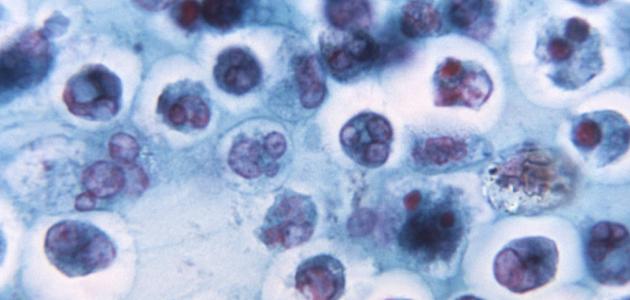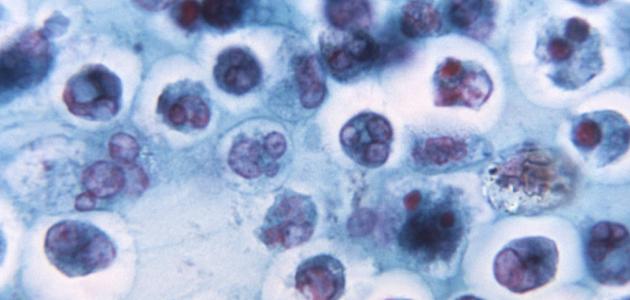General causes of leucopenia
Leukopenia, low white blood cell count, and leukopenia are all terms used to denote a low number of white blood cells in the blood that are produced in the bone marrow. When talking about the possible causes of a decrease in the number of white blood cells, knowing the processes that occur within the body and the resulting decrease in white blood cells is important, and these processes include the following:
- production decline: There are many factors that lead to a decrease in the production of white blood cells, as this may be due to problems affecting the bone marrow, and it may be due to malnutrition and a lack of important elements for the production of white blood cells, including vitamins, proteins, and calories.
- Increase smashing: As the white blood cells break down and disintegrate very quickly by the antibodies (in English: Antibodies) that are produced in the event of some disorders such as autoimmune disorders (in English: Autoimmune disorders), and they mean problems in which the immune system produces antibodies that fight the body’s natural cells instead of Fighting pathogens and infections.
- Consumption increase: This occurs in the event that the body suffers from infection, especially severe ones, such as sepsis, which is also called sepsis, where the body's stock of white blood cells is used up to fight infection beyond the usual limit.
- Detention: It means imprisoning and isolating white blood cells and accumulating them in the spleen (in English: Spleen) as a result of certain pathological conditions such as cirrhosis.
Diseases and conditions that may cause leukopenia
A deficiency of white blood cells may result from several causes and conditions, which can be described as follows:
Read also:flu symptoms- Infection: Infection is one of the common causes of low white blood cell count, and this may occur in the post-infection stage in some types of infections or during acute infection in some cases, and in general, the types of infections that cause a decrease in white blood cells are:
- Viral infection caused by the Epstein-Barr virus, respiratory syncytial virus, parvovirus, influenzae virus, and cytomegalovirus Cytomegalovirus), viruses responsible for hepatitis A, hepatitis B, measles virus, dengue fever virus, and human immunodeficiency virus. (in English: Human Immunodeficiency Virus (HIV)).
- Rickettsia diseases such as: Lyme disease, Ehrlichiosis, anaplasmosis, typhus, and Rocky Mountain spotted fever.
- Bacterial infections such as: infection with Shigella bacteria, Salmonella bacteria, Whooping cough bacteria, Brucellosis bacteria, and Tuberculosis bacteria. , strains of atypical mycobacteria, and bacteria that cause parrot fever (Pisttacosis).
- Parasites, including malaria.
- Bone marrow problems: The bone marrow is called what is known as the spongy center of the bones and is responsible for making blood cells. Problems in the bone marrow may harm its ability to produce white blood cells. For example, an environment full of chemicals such as benzene and pesticides affects the ability of the bone marrow to produce blood cells. The same applies to some types of cancer and its chemotherapy and radiation treatments.
- Autoimmune diseases: As these diseases include the body attacking and destroying its white blood cells, the most prominent of these diseases are lupus and rheumatoid arthritis.
- Malnutrition: Malnutrition causes a failure to obtain the required levels of vitamins and nutrients important for the manufacture of white blood cells, such as folic acid and vitamin B12. On the other hand, consuming harmful products such as alcohol can negatively affect In the body's stores of nutrients and its number of white blood cells.
- Spleen related disorders: The infection of the spleen, or its exposure to a blood clot, and any other problem that could affect its performance and lead to its enlargement, and thus the number of white blood cells in the body decreases because it is one of the organs producing white blood cells as well, and one of the most prominent problems of the spleen is its overactivity, which means that it destroys The spleen has white blood cells as a result of its enlargement, which leads to a decrease in their number and the occurrence of anemia (in English: Anemia).
- geranium: Also called sarcoidosis, it is an autoimmune disease that causes inflammation in small parts of the body through an overreaction of the immune system. Sarcoidosis can affect the bone marrow, thus leading to a decrease in white blood cells.
- Childbirth disorders: Congenital disorders, such as Kostmann syndrome.
Treatments and medications that may cause leukopenia
Often, the mechanism of action by which drugs affect the number of white blood cells is related to the immune system of the body, and some drugs, on the other hand, cause a decrease in the number of white blood cells by inhibiting the bone marrow, such as chemotherapy drugs for cancer. White blood cells:
Read also:Hereditary hair loss treatment- Cancer treatments: These include chemotherapy, radiation therapy, and bone marrow transplant.
- Other medicines: Among them we mention the following:
- Clozapine is a type of antipsychotic.
- Antiepileptic drugs such as: sodium valproate and lamotrigine.
- Immunosuppressive drugs used in organ transplantation, such as: Sirolimus, Tacrolimus, Mycophenolate mofetil, and Cyclosporine.
- Interferon, used in the treatment of multiple sclerosis.
- The drug used to treat smoking addiction and the antidepressant known as Bupropion.
- Some antibiotics such as: penicillin and minocycline.
Idiopathic leukopenia
The term idiopathic is used when the cause of leucopenia is not known despite extensive investigations, eg chronic idiopathic neutropenia.
Causes of low white blood cells according to their type
White blood cell deficiency may not include all types. In some disease cases, a type of white cell type decreases, while others remain within their normal levels. This may help detect the presence of a particular disease and predict its severity.
Read also:The benefits and harms of snowLow neutrophils
There are two methods that cause the occurrence of neutropenia, the first is the inability of the bone marrow to produce the body’s need of these cells, and the other is the speed of using and destroying neutrophils in a way that does not correspond to the speed of their production, and several reasons fall under these two methods, which can be mentioned as follows following:
- Various infections such as: hepatitis, tuberculosis, sepsis, and Lyme disease.
- Medications, especially chemotherapy, are the most common causes of neutropenia.
- Cancer, bone marrow diseases, and other blood diseases.
- Malnutrition and lack of vitamins and minerals necessary for building neutrophils, such as: copper, vitamin B12, and folic acid.
- Autoimmune diseases such as: Crohn's disease, lupus, and rheumatoid arthritis.
Decreased eosinophil count
Usually, a low eosinophil count is not considered a problem that affects the health of the body, as other parts of the immune system compensate for the deficiency, and a low eosinophil count is usually detected during a complete blood count for other purposes, and one of the most prominent pathological conditions associated with low eosinophil counts Eosinophilia, Cushing syndrome, sepsis, and taking corticosteroids.
Basophil deficiency
Basophils deficiency is usually associated with several pathological conditions, the most prominent of which are the following:
- Allergic diseases such as: urticaria, angioedema, anaphylaxis, also called anaphylaxis, and severe allergic reactions.
- Long-term use of corticosteroids and their use in high doses.
- Stress and tension.
- The acute phase of infection and inflammation.
- Hyperthyroidism and thyrotoxicosis.
Lymphocytopenia
Lymphocytopenia is a disease in which there is a decrease in the number of a certain type of white blood cells known as lymphocytes, and lymphocytopenia occurs as a result of many diseases, conditions, and factors that may be acquired or inherited, and by acquired we mean those that It was not present at birth, but was developed afterward. As for inherited, it means that which is carried on genes and passed on from parents to children. Below is a mention of the causes of lymphocytopenia in more detail:
- Acquired causes: Conditions, diseases, and acquired factors include all of the following:
- Diseases caused by infection such as: tuberculosis, AIDS, viral hepatitis, and typhoid fever.
- Lupus and other autoimmune diseases.
- Steroid medication use.
- Blood diseases such as: blood cancers, Hodgkin's disease, and aplastic anemia.
- Radiation and chemotherapy for cancer.
- Inherited causes: Rare inherited diseases include DiGeorge anomaly, Wiskott-Aldrish syndrome, Severe combined immunodeficiency syndrome, and ataxia-telangiectasia. telangiectasia).
Decreased monocyte count
A decrease in the monocyte count occurs as a result of several reasons, and it is said that there is a decrease in the number of monocytes if their number is less than 500 cells per microliter of blood, and the most prominent reasons for its decrease are the following:
- Myelosuppression that occurs as a result of chemotherapy with a decrease in other types of white blood cells known as cytopenia.
- A mutation in the blood-forming cells.
- Cancerous tumors such as: Hodgkin's lymphoma, acute lymphoblastic leukemia, and hairy cell leukemia.
- Infections such as: AIDS, Epstein-Barr virus, adenovirus, and miliary tuberculosis.
- Treatment with corticosteroids and immunoglobulin.
- Resection of the intestine and stomach.
- Temporary low monocyte count that occurs as a result of endotoxin, during hemodialysis, and cyclic neutropenia.









